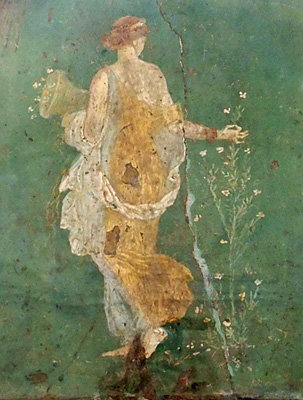 Flora,
cubiculum fresco
Flora,
cubiculum frescoVilla Ariadne, Stabiae (15-45 CE)
 Flora,
cubiculum fresco
Flora,
cubiculum frescoThe woman introduced in the passage below is identified not by name, family or social status, but only by having crossed the biological threshold of puberty (menarche), shared with the mammalian kingdom (quae iustis tum demum operata iuvencae/legibus), that enables her to bear young. The text reflects an amalgam of ancient Greco-Roman conceptions about the unique powers inherent in female bodies; some of these beliefs have survived in Latin in medical texts, agricultural instructions of Cato the Elder (234-149 BCE) and Columella (4-c. 70 CE), encyclopedic entries in the Noctes Atticae of Aulus Gellius (c. 125-180 CE), and "scientific" observations in the Naturalis Historia of Pliny the Elder (c. 23-79 CE). Lucius Junius Moderatus Columella, thought to have been born to Roman parents in Gades, Hispania Baetica, wrote his manual on agriculture, preserved in twelve books, in the mid-first century CE, for upper-class landowners of family farms and extensive estates. He included much advice on how these landowners could use magic to manipulate, control, even coerce, supernatural agencies to promote or counter some natural event, such as adverse weather, infertility of fields and orchards, or an infestation of pests. His sources include Greek and earlier Roman writers on agriculture, and seers and mages from Etruria and Phoenicia who posited that the human body had magical powers that could be summoned to protect crops and farm animals; for example, the gaze of the paterfamilias could promote the growth of crops (RR 4.18). Among bodily fluids, women's menstrual blood was particularly potent. In his book "Remedies Derived from Living Creatures," Pliny the Elder devotes a whole chapter (NH 28.23) to "the marvellous powers attributed to females during menstruation," both positive (e.g., they could drive away hail and whirlwinds and storms at sea) and negative (e.g., in their presence bees leave their hives, razors become dull, pregnant mares miscarry), including employing a menstruating woman to magically remove caterpillars from crops (see Columella's version below). De Re Rustica X is composed in dactylic hexameter, perhaps in homage to Vergil's Georgica (29 BCE), four books of poetry containing advice to the gentleman farmer interspersed with myths and themes of life and death. In Book XI, Columella provides a prose version of his instructions for ridding plants of caterpillars (De Cultu Hortorum 63-64), citing Democritus as his source at the end of the passage. For further reading on Roman belief in the powers inherent in women's bodies, see Ager's Roman Agricultural Magic (2010) and her SCS abstract (2015), and Richlin, "Pliny's Brassiere" in Arguments With Silence (2014) in the Bibliography.
At si nulla valet medicina repellere pestem,
Dardaniae veniant artes nudataque plantas
femina, quae iustis tum demum operata iuvencae
360 legibus obsceno manat pudibunda cruore,
sed resoluta sinus, resoluto maesta capillo,
ter circum areolas et saepem ducitur horti.
Quae cum lustravit gradiens, mirabile visu,
non aliter quam decussa pluit arbore nimbus
365 vel teretis mali vel tectae cortice glandis,
volvitur in terram distorto corpore campe.
Sic quondam magicis sopitum cantibus anguem
vellere Phrixeo delapsum vidit Iolcos.
Click on the underlined words for translation aids and commentary, which will appear in a small window. Click on the icon link![]() to the right of the line for related images and information.
to the right of the line for related images and information.